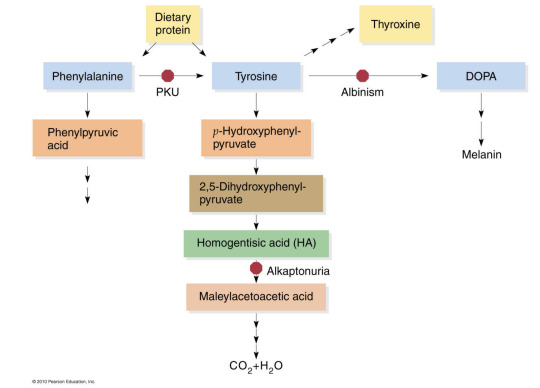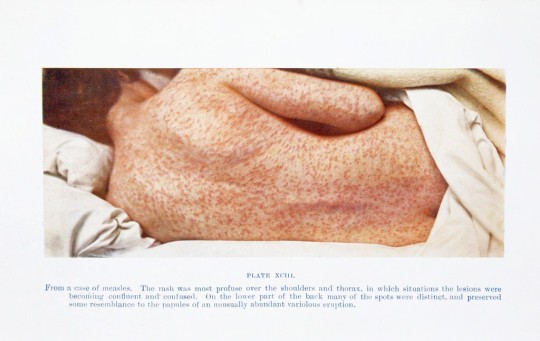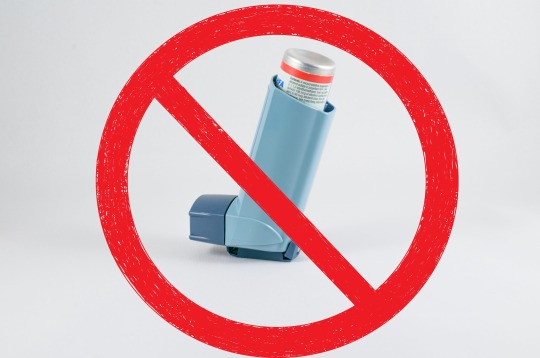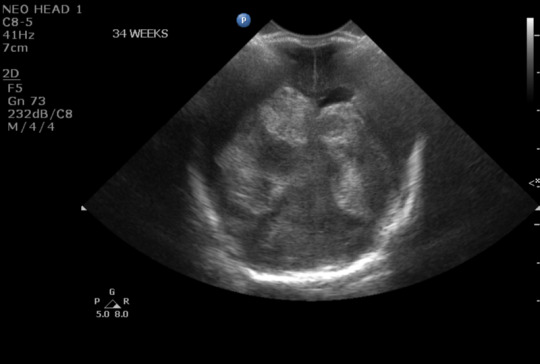#teachingrounds
Text

"Phenylalanine is a primary amino acid that is abundant in dietary protein. It's main metabolic pathway yields the amino acid Tyrosine, which is involved in the production of Melanin pigments. Defects of enzymes responsible for interconversion of metabolites in the pathway are the cause of three well-studied, single-gene Inborn Errors of Metabolism: Phenylketonuria (PKU), Albinism (Melanin deficiency), and Alkaptonuria (excess HA)."
(C) 2010 P.J. Russell, iGenetics 3rd ed, (c) 2014 by Steven M. Carr.
30 notes
·
View notes
Text

Rheumatoid arthritis is a well-known cause of inflammatory polyarthropathy that affects hands, feet, and other joints.
RA also has many potential extra-articular manifestations, as shown in the image.
Reference: FA Figus, et al. Autoimmunity Reviews 2021 (20),
#TeachingRounds#FOAMEd#FOAMRad#internalmedicine#familymedicine#rheumatology#arthritis#rheumatoidarthritis
3 notes
·
View notes
Text
The Healing Frequencies of the Human Body:
* Hammered dulcimer
* Singing bowls
* Gongs
* Windchimes
* Pan flutes
* Hang
* Didgeridoo
* Kalimba
* Djembe
* Rainstick
* Drums
The Solfeggio frequencies are a six-tone set of musical tones that date back to ancient times.
* 396 Hz: liberation from negative feelings
* 417 Hz: transformation and fixing broken situations
* 528 Hz: miracles and DNA repair
* 639 Hz: interpersonal relationships
* 741 Hz: solving problems, solutions, creative expression
* 852 Hz: spiritual enlightenment
40Hz
Flickering lights and sounds at 40 hertz have been used in Alzheimer’s therapy studies to stimulate an increased neural response and fight symptoms of dementia. Sound at 40 hertz has been linked to gamma brain waves and the stimulation of memory.
174z
174 hertz is one of the Solfeggio frequencies, a series of tones used in sacred music that is believed in alternative medicine to have different positive effects on human health. 174 hertz is associated with the reduction of both pain and stress.
285Hz
285 hertz is also one of the Solfeggio frequencies and is considered instrumental in the healing of cuts, burns, and other physical wounds. 285 hertz sound frequencies are supposed to activate the body into cellular regeneration, encouraging it to heal itself in the event of an injury.
396Hz
This sound frequency is associated with the removal of fear and other negative feelings. As one of the Solfeggio frequencies, the 396 hertz tone aids in the removal of the feeling of guilt, making it an effective addition to spiritual music. 396 hertz frequencies balance the root chakra while simultaneously transforming negative emotions such as grief into positive, joyful ones.
417Hz
Instead of a focus on physical ailments, healing sound therapy involving 417 hz (another of the Solfeggio frequencies) focuses on the removal of negative energy such as the energy surrounding a past trauma or negative energies in the ambient environment. 417 hertz therapy is designed to dissolve emotional blockages and activate the sacral chakra.
432Hz
432 hertz therapy is aimed at the heart chakra and listening to a 432 hertz frequency is supposed to lead to greater levels of mental and emotional clarity. A 432 hertz tuning is associated with a higher level of spiritual development.
440Hz
Music that is tuned to the 440 hertz versus 432 hertz is considered “cerebral” music that aids in the listener’s cognitive development. Sound frequencies at 440 hertz are considered to activate the third eye chakra.
528Hz
Also known as the love frequency, 528 hertz is one of the most well-known and popular of the Solfeggio frequencies. This musical tone is also known as the “miracle note” and has been used in native populations as a sound associated with blessings since before written history.
639Hz
639 hertz is a sound frequency that affects the heart chakra. This sound frequency is associated with therapy intended to produce positive feelings and greater attunement to harmonious interpersonal relationships. As therapy, 639 hertz exposure encourages clearer communication practices and situational awareness.
852Hz
852 hertz sound therapy is a tone that is associated with redirecting the mind away from overthinking, intrusive thoughts, and negative thought patterns. These patterns of thought play a larger role in depression and anxiety. Exposure to this sound frequency can help the role of negative thoughts in these psychological ailments.
963Hz
963 hertz sound frequencies are associated with activation of the pineal gland and higher spiritual development. The 963 hertz frequency is known as both the “pure miracle tone” and the “frequency of the gods”. 963 is associated with the activation of the crown chakra and a connection to the source of all humanity.
Not only are low-frequency sounds associated with human illness, but they’re also associated with annoyance, lack of ability to focus or concentrate, and the inability to retain information (memory issues). The government took the application of low-frequency sound as a weapon even further, incorporating infrasonic sound technology into crowd dispersal vehicles such as LRAD tanks. These sonic tanks produce a low-frequency sound designed to induce immediate nausea and dizziness.
full list of negative symptoms associated with low-frequency sound exposure:
* Loss of sleep —
* Irritability —
* Fatigue —
* Loss of concentration —
* Nausea —
When exposed to higher frequencies, such as those found in frequency healing, the human body is stimulated to heal oneself. On the flip side of that, if the human body is exposed to constant low-frequency noises, they can develop negative symptoms as a result.
#spirituality#ancestors#frequency#chakras#heartchakra#sacralchakra#pinealgland#visualization#annunaki#witches of tumblr#self care#positivity#teachingrounds#virgo sun#leo moon#sagittarius rising#science#humanity#woke culture#karma#nakia
197 notes
·
View notes
Text

Why do people (ie. my students) feel so depressed when they see Hopper's paintings? They came up with such dreary scenarios 😨 while I just see the light, the peace and the colors smoothly blending in. Everything is quiet and hung up in time.
3 notes
·
View notes
Photo

FARE (Food Allergy Research and Education) wants you to join the Teal Pumpkin Project in offering treats this Halloween that are safe for trick-or-treaters with food allergies.
331 notes
·
View notes
Text
Q. Do you recognize this rash?

A. Measles (rubeola) is an infectious disease caused by a single-stranded Paramyxoviridae RNA virus. After infection, the virus incubates for ~10 days. First come fever, congestion, conjunctivitis, and a highly infectious "barking" cough that spreads respiratory droplets. 3-4 days later a rash appears. All symptoms intensify for 3-4 days and then resolve. Late winter and spring is prime time for measles infections.
Source: Craft, Fox, Goldsmith, "Measles in Child"; image from Wellcome Collection
5 notes
·
View notes
Text

Happy National Doctors Day!
5 notes
·
View notes
Text

Today's case is a mass at the cerebellopontine angle (CPA) with classic features of an extra-axial tumor: CSF cleft (yellow arrow), displacement of subarachnoid vessels (blue arrow), and displacement of gray matter (red arrow). In addition, there is expansion of the subarachnoid space along the skull base anterior/lateral to the mass.
Differential diagnosis of a CPA mass in an adult is schwannoma, meningioma, ependymoma, and metastasis (note that ependymoma is intra-axial). Of these, schwannoma is by far the most common at this location (90%), and this was indeed a schwannoma.
Image credit: radiologyassistant.nl
24 notes
·
View notes
Text
Did you know that antibiotic resistance is as old as antibiotics themselves?

#TeachingRounds#FOAMed#infectiousdisease#microbiology#bugsanddrugs#antibioticresistance#historyofmedicine#medicalhistory
36 notes
·
View notes
Text
While the most common misplaced objects removed from adult orifices are insects...
...and the most common "foreign body ingestion" in adults is an impacted food bolus, the most common foreign bodies that children swallow are coins (mostly pennies) but increasingly button batteries.
6 notes
·
View notes
Text

Not all "difficulty breathing during exertion" is "exercise-induced asthma."
If someone has SOB, wheezing, and difficulty EXhaling with any kind of exercise, treat as asthma with a beta-2 agonist.
Exercise-induced bronchoconstriction (EIB) develops after 5-15 minutes of exertion (especially in dry air, like a track rather than the wet air of a pool) and lasts ~15 mins. Warm up for 10-15 mins +/- beta-2 agonist. May be asthma precursor.
Exercise-induced laryngeal dysfunction and/or vocal-cord dysfunction (VCD) is difficulty INhaling +/- stridor due to exertion. Refer to Speech for vocal relaxation rather than a beta-2 agonist.
17 notes
·
View notes
Text

Today's case is a 70-year-old woman with bilateral thigh pain. Radiograph of the femurs reveals cortical irregularities of the lateral femurs, the classic location and appearance of bisphosphonate-related stress fracture. This is an atypical location for stress fractures in a patient who is not taking bisphosphonates.
Case courtesy of Matt Skalski, Radiopaedia.org, rID: 46147
5 notes
·
View notes
Text
youtube
Q. What does an atrial septal defect (ASD) sound like on auscultation?
.
.
.
.
.
A. Unlike ventricular septal defects (VSDs), an inter-atrial defect causes no murmur itself. However, a number of adventitious sounds may be associated with it.
- wide and fixed S2, due to the larger-than-normal volume of blood that is sent through the right-sided circulation, causing a later-than-normal closing of the pulmonary valve (the second sound in S2)
- a crescendo-decrescendo early systolic ejection murmur from the pulmonic valve heard best at the right upper sternal border (RUSB)
- a rumbling mid-diastolic murmur from blood rushing through the tricuspid valve heard best at the left lower sternal border (LLSB)
Pro-Tip: S2 is only wide and fixed when pulmonary resistance is low; if the defect remains open long enough, the extra blood flow will increase pulmonary vascular resistance, decreasing blood flow into the lungs and across the ASD, eventually resulting in Eisenmenger Syndrome.
Example courtesy of Thinklabs
3 notes
·
View notes
Text

Levetiracetam (Keppra) is one of the few anti-epileptic drugs (AEDs) that is renally secreted. If a patient with seizures on Keppra has renal failure and cannot or does not want to be switched to a different AED, they can have their Keppra renally dosed (after dialysis). Keppra overdose can cause sleepiness, aggression/behavioral problems (peds>adults), hypertension (peds), vomiting.
Image: DrawItToKnowIt
10 notes
·
View notes
Text
#TeachingRounds is completing its 6th year...
...so this week we're re-sharing our most popular posts, such as this #clinicalpearl about Group B Strep UTIs in pregnancy.

If a pregnant person has a Group B Streptococcus (GBS) UTI, then they will later need IV prophylaxis during delivery (except for scheduled C section with intact membranes). Guidelines recommend penicillin G or ampicillin, or if allergic then cefazolin, clindamycin, or vancomycin for at least 2-4 hours before birth.
#TeachingRounds#FOAMed#infectiousdisease#pregnancy#womenshealth#UTI#pharmacology#bugsanddrugs#year in review
4 notes
·
View notes
Text

Today's case is an intracranial ultrasound of a 2-week-old neonate born at 24 weeks. A single coronal image depicts the ventricles which should be hypoechoic but are instead nearly completely filled with echogenic material, compatible with intraventricular hemorrhage (IVH). There is likely extension into periventricular white matter on the right.
IVH is a common complication seen in preterm neonates and is often described in four grades, as outlined below. This case is a grade 4 IVH.
Grade 1. Bleeding occurs just in a small area of the ventricles.
Grade 2. Bleeding also occurs inside the ventricles.
Grade 3. Ventricles are enlarged by the blood.
Grade 4. Bleeding into the brain tissues around the ventricles.
(Credit Children's Hospital of Philadelphia, https://www.chop.edu/conditio.../intraventricular-hemorrhage)
Case courtesy of Ryan Thibodeau, Radiopaedia.org, rID: 166948
12 notes
·
View notes